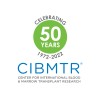
UCB Transplant for Hematological Diseases Using a Non Myeloablative Prep
Acute LeukemiaAcute Myeloid Leukemia23 moreThis is a phase II trial using a non-myeloablative cyclophosphamide/ fludarabine/total body irradiation (TBI) preparative regimen with modifications based on factors including diagnosis, disease status, and prior treatment. Single or double unit selected according to current University of Minnesota umbilical cord blood graft selection algorithm.

Significance of Duration of Maintenance Therapy With Rituximab in Non-Hodgkin Lymphomas
Follicular LymphomasImmunocytomas4 moreThe purpose of this study is to determine if an extended maintenance therapy with Rituximab in follicular and a maintenance therapy in other indolent and mantle cell lymphomas has advantages compared to a shorter or no maintenance therapy.

Umbilical Cord Blood Transplant, Cyclophosphamide, Fludarabine, and Total-Body Irradiation in Treating...
Acute Biphenotypic LeukemiaAcute Lymphoblastic Leukemia19 moreThis phase II trial studies how well giving an umbilical cord blood transplant together with cyclophosphamide, fludarabine, and total-body irradiation (TBI) works in treating patients with hematologic disease. Giving chemotherapy, such as cyclophosphamide and fludarabine, and TBI before a donor umbilical cord blood transplant helps stop the growth of cancer and abnormal cells and helps stop the patient's immune system from rejecting the donor's stem cells. When the healthy stem cells from a donor are infused into the patient they may help the patient's bone marrow make stem cells, red blood cells, white blood cells, and platelets. Sometimes the transplanted cells from a donor can make an immune response against the body's normal cells. Giving cyclosporine and mycophenolate mofetil after transplant may stop this from happening.

Haploidentical Allogeneic Peripheral Blood Transplantation: Examining Checkpoint Immune Regulators'...
Acute Myeloid LeukemiaChronic Lymphocytic Leukemia8 moreThe standard Johns Hopkins' regimen will be used in study subjects, with the use of donor peripheral blood stem cells, rather than marrow. Clinical outcomes will be defined while focusing efforts on immune reconstitution focusing on immune checkpoint regulators after a related haploidentical stem cell transplant.

Front-line VenObi Combination Followed by Ven or VenZan Combination in Patients With Residual Disease:...
High Risk CLLChronic Lymphocytic LeukemiaMulticentric phase 2 study for previously untreated high-risk CLL patients. Patients will receive 6 courses of the Venetoclax + Obinutuzumab combination. Patients with stable disease or a response (CR/PR) with uMRD in the PB and BM at cycle 9 will continue treatment with Venetoclax single agent until cycle 13 and then stop treatment. Patients with stable disease or a response (CR/PR) with evidence of residual disease in the PB and/or BM at cycle 9 will continue treatment with Venetoclax and Zanubrutinib combination until cycle 21. then, Patients with uMRD in the PB and BM at cycle 21 will stop treatment whereas patients with residual disease in the PB and/or BM at cycle 21 will discontinue Venetoclax and continue Zanubrutinib until disease progression.

HLA-Mismatched Unrelated Donor Peripheral Blood Stem Cell Transplantation With Reduced Dose Post...
Acute Lymphoblastic LeukemiaAcute Myeloid Leukemia9 moreThe goal of this clinical trial is to determine the effectiveness of Reduced Dose Post-Transplant Cyclophosphamide (PTCy) in patients with hematologic malignancies after receiving an HLA-Mismatched Unrelated Donor (MMUD) . The main question[s] it aims to answer are: Does a reduced dose of PTCy reduce the occurrence of infections in the first 100 days after transplant? Does a reduced dose of PTCy maintain the same level of protection against Graft Versus Host Disease (GvHD) as the standard dose of PTCy?

PICAROS - Acalabrutinib RWE on 1L CLL in Spain
Chronic Lymphocytic LeukemiaThis is a multicenter non-interventional study (NIS) on patients with CLL who have been treated with acalabrutinib for the first time within the year before the first site initiation visit in Spain.

HEALTH4CLL2: A Randomized Waitlist Control Trial of Behavioral Interventions in Patients With Chronic...
Chronic Lymphocytic LeukemiaTo learn if exercise and weight management can help to improve feelings of fatigue in CLL survivors.

Economic Analysis of Early vs Delayed Therapy in Newly Diagnosed Asymptomatic High-Risk Patients...
Chronic Lymphocytic LeukemiaSmall Lymphocytic LymphomaUtilization data will be collected from all patients entered on the trial at Canadian centres from the time of registration until death, removal from study, or completion of 10 years of follow-up. Protocol-specified health care utilization will be collected within trial case report forms, and will include study visits, radiographic assessments, laboratory investigations, and treatment administration. Resource utilization data collection will be supplemented by a self-administered resource utilization form (Stanford SMRC) to document non-protocol specified utilization. This will include hospitalizations (including days in hospital), emergency room visits, and non-protocol specified ambulatory visits.

A Study of the Safety and Efficacy of Venetoclax for Participants With Chronic Lymphocytic Leukemia...
CancerChronic Lymphocytic Leukemia (CLL)This observational study will evaluate the safety and effectiveness of Venetoclax used in routine clinical practice for participants diagnosed with chronic lymphocytic leukemia (CLL).
